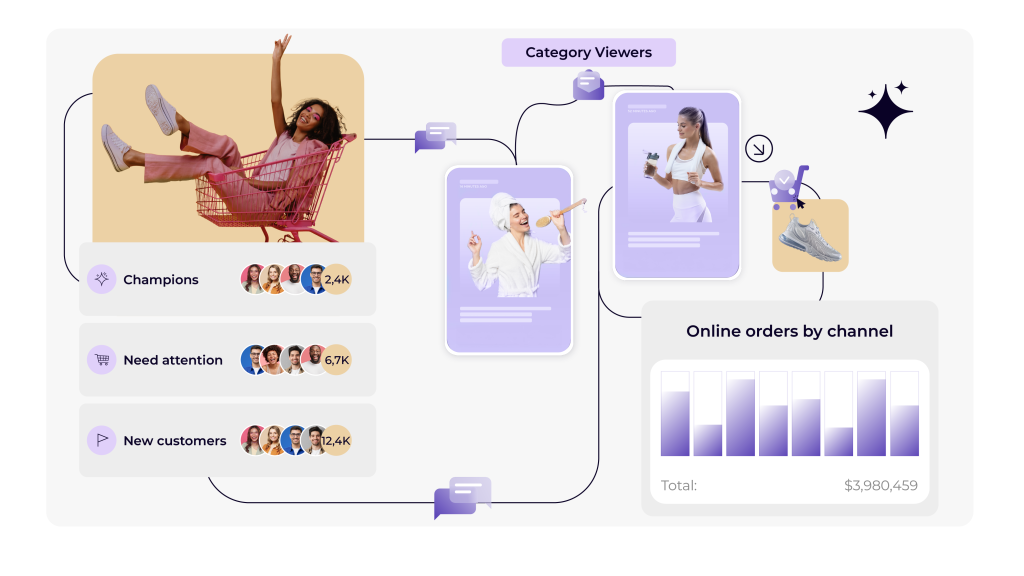RFM Segmentation: Turning Customer Data Into Real Relationships

Not all customers are the same. Some shop every week, some only once a year. Some spend big, others just test the waters. Treating them all the same way wastes marketing effort, and worse, pushes valuable customers away.
That’s where RFM segmentation comes in. It’s a simple yet powerful framework that groups customers by how recently they purchased, how often they buy, and how much they spend. Instead of one-size-fits-all campaigns, you get precise, data-driven strategies that deepen engagement and boost ROI.
According to a 2020 Bain & Company study, companies that employ advanced customer segmentation achieve about a 10% higher customer retention rate than peers.
What Is RFM Segmentation?
RFM segmentation stands for:
- Recency: How recently a customer purchased.
- Frequency: How often they purchase.
- Monetary: How much they spend.
By combining these three metrics, RFM segmentation helps you identify who’s loyal, who’s slipping away, and who’s worth reactivating. It turns transaction data into customer insight, powering smarter communication and retention strategies.
👉 Use PersonaClick’s Segmentation Engine to automatically calculate and refresh RFM scores without manual effort.
Why RFM Segmentation Matters in Marketing
RFM segmentation transforms raw customer data into actionable insights that deliver measurable business results.
- Smarter Campaigns: Send offers that match customer behavior instead of blanket promotions.
- Higher ROI: Focus budget on customers most likely to convert.
- Improved Relationships: Personal, relevant messaging builds long-term loyalty.
- Retention Power: It’s more cost-effective to retain a customer than to acquire a new one.
In short: RFM segmentation makes your marketing more personal, efficient, and impactful.
Examples of RFM Segmentation in Action
Let’s visualize how RFM segmentation translates into marketing strategy:
- Loyal Customers: Purchase regularly and respond well to engagement campaigns. Reward them with exclusive access or loyalty points.
- Recent Customers: Just made their first purchase, which is a perfect time for onboarding and cross-selling.
- At Risk: Previously high spenders who haven’t returned. Reactivate them with personal offers or reminders of what they’re missing.
Each segment receives a tailored tone, timing, and incentive. That’s the clarity RFM segmentation provides.
The Role of Data and Automation in RFM Segmentation
Doing RFM segmentation manually can be complex especially at scale. With AI and automation, you can:
- Update RFM scores daily using live behavioral data.
- Trigger automated campaigns (email, SMS, or web push) based on segment changes.
- Analyze performance by segment with PersonaClick’s Analytics Dashboard.
Automation ensures your RFM model stays accurate, responsive, and continuously optimized.
How PersonaClick Simplifies RFM Segmentation
At PersonaClick, we’ve automated the heavy lifting behind RFM segmentation so you can focus on strategy, not spreadsheets.
Our dashboard provides real-time insights such as:
- Champions: 26,951 customers
- Loyal Customers: 6,894 customers
- At Risk: 15,293 customers
From there, you can launch campaigns tailored to each group—rewarding Champions, onboarding new buyers, or winning back at-risk segments with a few clicks.
Why RFM Segmentation Is a Game-Changer
Without segmentation, marketing is guesswork. With RFM segmentation, it becomes data-driven precision.
- Engage the right audience at the right moment.
- Spend marketing resources efficiently.
- Strengthen loyalty with personalized recognition.
- Reactivate high-value customers and prevent churn.
👉 PersonaClick’s Automation Engine helps you activate RFM segments in real time, ensuring campaigns reach the right customers exactly when it matters.
FAQs About RFM Segmentation
- What is RFM segmentation used for?
It’s used to categorize customers based on recency, frequency, and monetary value, helping marketers deliver personalized campaigns and retention strategies. - How does RFM segmentation improve ROI?
By focusing efforts on customers most likely to engage or purchase, RFM segmentation reduces wasted spend and increases profitability. - Is RFM segmentation suitable for all industries?
Yes. Whether e-commerce, retail, or finance, any business that tracks transactions can benefit from RFM segmentation insights.
The Bottom Line: RFM segmentation converts data into action
RFM segmentation is one of the simplest yet most powerful ways to convert customer data into action. By grouping users based on recency, frequency, and spend, you create meaningful, relationship-driven marketing strategies.
And with PersonaClick, you don’t just analyze RFM segments; you activate them automatically.
✨ Ready to turn your customer data into stronger relationships? Book a Demo and discover how PersonaClick’s RFM segmentation engine personalizes engagement at scale.